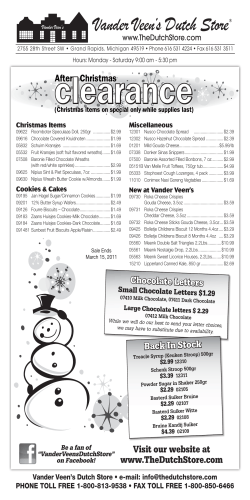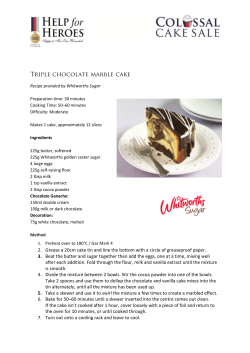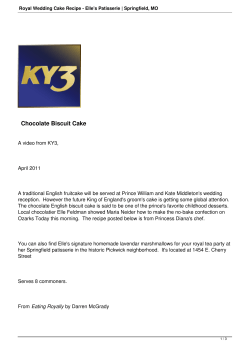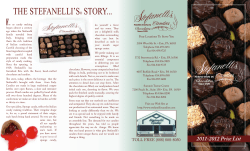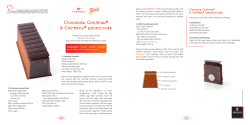
BLOMMER CHOCOLATE COMPANY TEMPERING CHOCOLATE TEMPERING
BLOMMER CHOCOLATE COMPANY TEMPERING CHOCOLATE TEMPERING The tempering of chocolate can be defined as the time-temperature process used to manipulate fat to develop the correct fat crystal type and size. The result is a product with better heat resistance, touch stability, glossy appearance, snap and release from moulding versus poor or non-tempered chocolate. Additionally, poorly tempered chocolate can form a white powdery substance called fat bloom. We at Blommer also understand that tempering encompasses both skill and science. This information should be used as a guide for tempering chocolate, but each formulation is different and therefore parameters need to be created for each product. TRIGLYCERIDES Cocoa Butter is comprised of various triglycerides, but mainly they are stearic-oleic-stearic (SOS), stearic-oleic-palmitic (SOP) and palmitic-oleic-palmitic (POP). Composition varies based on growing location with origins closer to the equator contain higher levels of saturated fat which will lead to harder cocoa butter. The most important aspect of tempering is the packing of the triglycerides into crystalline structure. In total there are 6 different crystal structures, but we are mainly concerned with alpha, beta prime and beta. Each structure is created at different temperatures, but formation of beta crystals are most desired. Its these beta crystals that will act as building blocks we want to replicate during tempering because they produce a more heat stable product. They have a melt point of about 93 F. They pack tighter and the result is a product with good contraction. Additionally the quantity and size of the crystal is very important. Too many crystals or "seeds" can result in product that is over-tempered and not as shiny. Under-tempered product lack the amount of crystals and it may take too long to set up if at all. The smaller crystals formed during tempering the better compacting of the crystals results in a better snap and contraction. There are many different ways to temper chocolate, but the end goal is always the same- create the correct crystals (beta) in the correct size and quantity. The following will describe a couple of different methods to temper both milk and dark chocolate. It’s important to realize that milk chocolate has a higher level of milk fat to contribute to the overall fat matrix. We recommend cooling and reheating milk chocolates 1.0-2.0ºF lower than dark chocolates to compensate for this difference. Milk fat is somewhat liquid at room temperature and thus lowers the melt point of the product. R&D, Sept 2011 BLOMMER CHOCOLATE COMPANY TEMPERING CHOCOLATE CHUNK METHOD The first method is known as the Chunk Method. Equipment needed for this is a melter with agitator and temperature controls and a hand held thermometer. 1. Chop or break chocolate into small chunks and place into the empty mixer. 2. Turn on the heating element and agitator on the melter. Allow the mass to melt and mix and check the temperature of the chocolate frequentlyreaches it reaches 115- 120º F. 3. Continue to agitate and turn off the heater on the unit. Start adding large chunks of already tempered chocolate (it's important that the seed chocolate is well tempered) into the melted chocolate. Stir the chunks into the chocolate until the temperature reaches about 89 º F for Dark Chocolate and 87-88º F for Milk Chocolate (add more if everything melts and temperature isn't where it needs to be). Remove the unmelted chunks for future use. 4. If after you remove the chunks from the chocolate the temperature goes above 92 º F you will need to go through the entire process again. If the product becomes too thick you can either add liquid chocolate (115-120 º F chocolate), but the temperature must not go above 92º F. 5. At this point you can apply the chocolate in the desired method. Its recommended not to coat products that are above 70 º F because you can “lock in” the heat and de-temper the chocolate. AUTOMATED TEMPERING METHOD Another common method is the Automated Tempering Method. Most industrial users of chocolate incorporate use of tempering machines that continuously temper chocolate without additional of tempered blocks. This can also be done without an automatic tempering unit. The only difference in the equipment needed above is that the melter will need to be heated as well as cooled. 1. Heat and agitate the mass of chocolate to 115-120 º F 2. Rapidly cool the dark chocolate to 82- 84 F and milk chocolate to 80- 82 º F. Continue to agitate during the process. 3. Reheat the dark chocolate to 87-89 ºF and milk chocolate to 86-88 ºF. 4. If the product becomes too thick you can either add liquid chocolate or warm the chocolate, but the temperature must not go above 92 ºF. 5. At this point you can apply the chocolate in the desired method. It’s recommended not to coat products that are above 70 º F because you can “lock in” the heat and de-temper the chocolate. COOLING THE CHOCOLATE Cooling of the chocolate is another important aspect in tempering. It should be done gradually as to not shock the chocolate. Shocking can cause the wrong cocoa butter crystal to replicate and the finished product will not have the same qualities as stated above. Most systems incorporate a cooling tunnel and should be set up as suchThe beginning of the cooling tunnel should have low air velocity on the product and temperatures in the range of 65 F. The second zone will typically be in the 45 ºF temperature range with more air being blown on the product. The third zone should be higher (65-68 º F) to prevent condensation on the finished product. The other important piece is the dwell time of the product in the cooling process. The amount of required cooling time is dictated by the quantity being cooled and it can be in the range of 10-30 minutes. Finally, it can take chocolate 24 to 48 hours to full solidify so the way the product is packaged and stored needs to be considered. R&D, Sept 2011
© Copyright 2025

